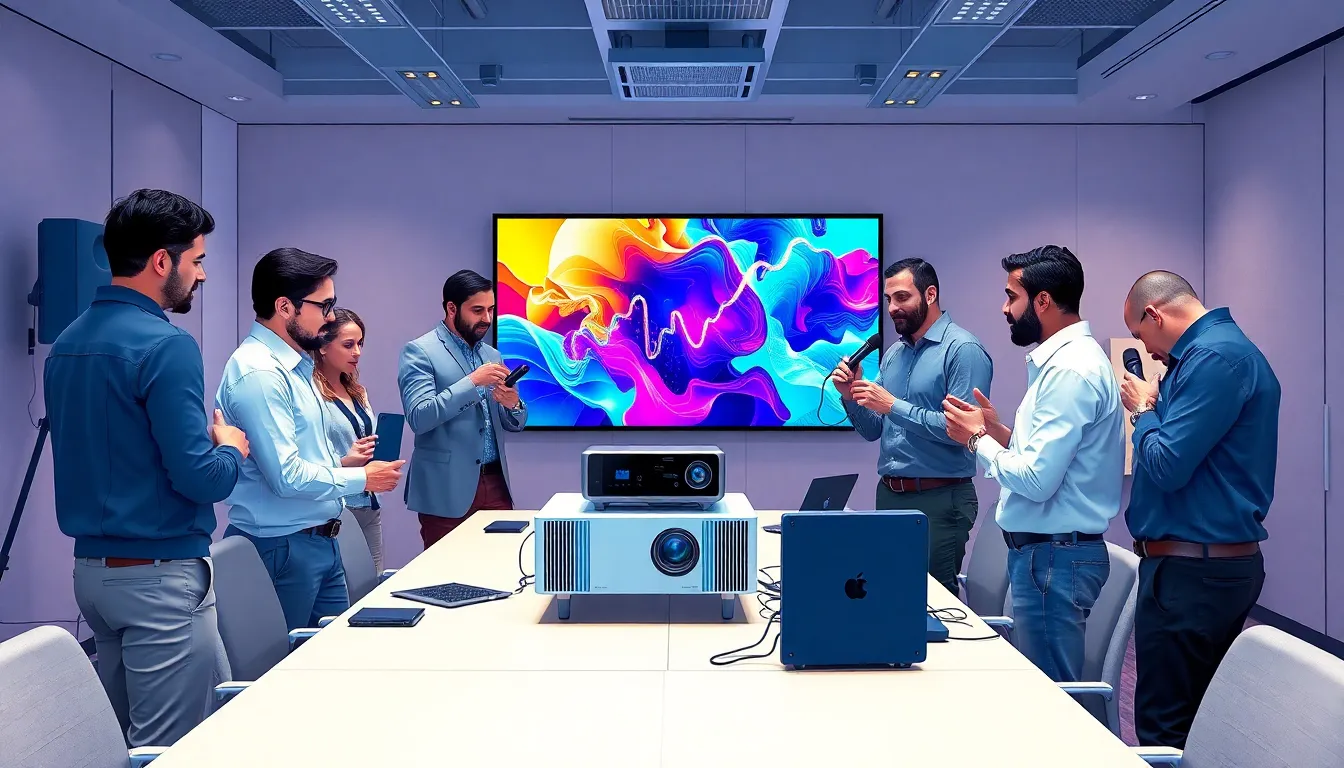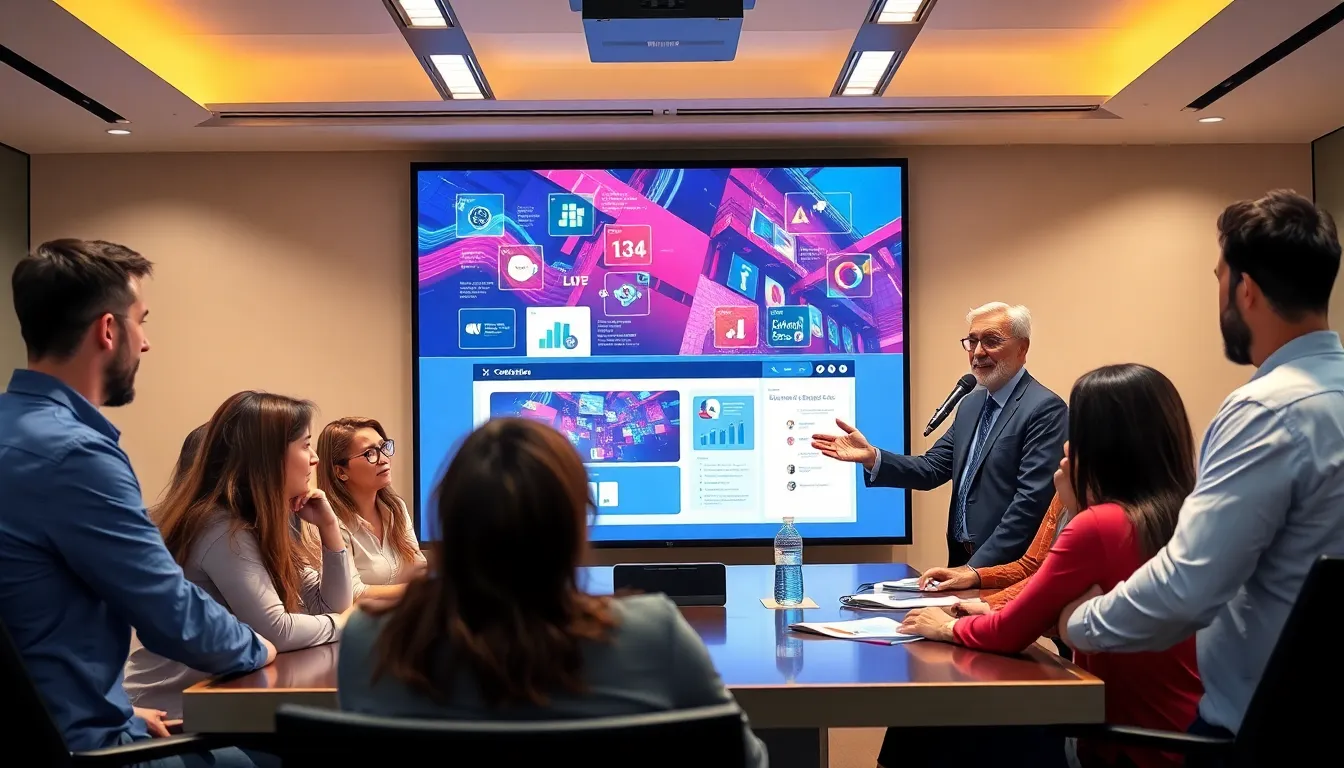In a world where a picture is worth a thousand words, audio visual technology takes that concept and cranks it up to eleven. It’s the magical blend of sound and sight that transforms mundane presentations into captivating experiences. Whether it’s a blockbuster movie or a corporate training session, this tech is the secret sauce that keeps audiences engaged and entertained.
Table of Contents
ToggleWhat Is Audio Visual Technology?
Audio visual technology refers to the tools and systems that integrate sound and visual components to create immersive experiences. This technology encompasses a wide range of equipment including projectors, speakers, microphones, and LED screens. Each element plays a crucial role in delivering high-quality presentations and facilitating effective communication.
Audio visual technology serves various purposes across multiple industries. In entertainment, it enhances films, concerts, and live events by synchronizing audio and video, resulting in a captivating viewer experience. In education, this technology aids teaching by using visual aids, interactive displays, and digital content to engage students. It transforms traditional classrooms into dynamic learning environments.
Corporate settings also benefit significantly from audio visual technology. Businesses use it for presentations, video conferences, and training sessions. High-definition video conferencing tools enable real-time collaboration between remote teams, improving productivity and engagement. Integrating visual content, such as graphs and animations, makes complex information more accessible.
The evolution of audio visual technology continues to shape how people interact and communicate. Innovations such as virtual reality (VR) and augmented reality (AR) offer cutting-edge experiences that blend real and virtual environments. These advancements push the boundaries of creativity and engagement in various fields.
Audio visual technology is essential for creating interactive and engaging experiences. Its applications span numerous sectors, enhancing everything from entertainment to education, and corporate communications. The integration of sound and visual elements fosters effective messaging and holds the potential to captivate audiences.
Components of Audio Visual Technology

Audio visual technology consists of various components that work together to create immersive experiences. These components include both audio and visual equipment, each serving vital roles in enhancing communication and engagement.
Audio Equipment
Audio equipment encompasses devices that capture, amplify, and reproduce sound. Important elements include microphones, speakers, and audio mixers.
- Microphones: Capture sound from speakers or performers, ensuring clear audio input. Types include dynamic, condenser, and lavalier microphones.
- Speakers: Reproduce audio at desired volume levels, enhancing listener experiences in events and presentations. Models vary from portable Bluetooth speakers to large PA systems.
- Audio Mixers: Combine audio signals from multiple sources, allowing for adjustments in levels and effects. These enable fine-tuning for optimal sound quality in any setting.
Visual Equipment
Visual equipment involves tools that display images and video content to audiences. Key components include projectors, screens, and LED displays.
- Projectors: Project images or videos onto surfaces, making them ideal for large audiences. Types include LCD, DLP, and laser projectors, each offering unique features and resolutions.
- Screens: Provide surfaces for displaying projected images, ranging from portable options to built-in models for permanent installations.
- LED Displays: Deliver high-resolution images and videos with vivid colors, often used in digital signage and large venues. These displays offer flexibility in size and configuration, accommodating various environments.
Applications of Audio Visual Technology
Audio visual technology serves multiple applications across various sectors, enhancing the quality of communication and engagement.
Education
Audio visual technology transforms education by facilitating interactive learning experiences. Classrooms equipped with projectors and interactive whiteboards allow educators to display multimedia content, making lessons more engaging. Online courses utilize video conferencing tools, enabling remote participation and collaboration among students and instructors. Educational institutions also incorporate simulation software and virtual labs, providing hands-on learning opportunities that enhance comprehension and retention. As a result, students become more actively involved in their education through dynamic and resourceful methods.
Entertainment
Audio visual technology significantly impacts the entertainment industry by enhancing content delivery. Film production employs advanced cameras, editing software, and surround sound systems to create captivating cinematic experiences. Live performances, including concerts and theater productions, utilize sophisticated sound systems and visual effects to engage audiences fully. Streaming services rely on high-quality audio and video formats to ensure optimal audience experiences. With the integration of VR and AR technologies, users can immerse themselves in interactive narratives, further revolutionizing entertainment consumption.
Business
Audio visual technology optimizes business communication and collaboration. Conference rooms equipped with video conferencing systems enable seamless virtual meetings, connecting teams across different locations efficiently. Presentation tools, such as digital signage and interactive displays, enhance engagement during business meetings and conferences. Moreover, companies leverage audio visual technology for training and onboarding, using instructional videos and e-learning platforms to improve employee skills. By streamlining communication and offering innovative training solutions, businesses can enhance overall productivity and collaboration among their workforce.
Benefits of Audio Visual Technology
Audio visual technology delivers numerous benefits across various fields, enhancing both communication and presentation effectiveness.
- Enhanced Engagement
Enhanced engagement occurs as audio visual elements capture audience attention. Dynamic visuals combined with compelling audio create immersive experiences that hold interest longer than traditional methods.
- Improved Retention
Improved retention results from the use of multimedia. Studies indicate that people retain 65% of information through a combination of sight and sound compared to just 10% through text alone.
- Increased Accessibility
Increased accessibility ensures that diverse audiences can easily engage with content. Audio visual technology aids in providing captions, translations, and descriptive audio, making materials available for individuals with disabilities.
- Streamlined Communication
Streamlined communication facilitates clarity in presentations. Visual aids help clarify complex concepts, making information easier to understand and reducing misunderstandings.
- Cost-Effectiveness
Cost-effectiveness emerges from the use of unified systems. Investing in integrated audio visual solutions reduces the need for separate technologies, minimizing operational and setup costs.
- Flexibility and Versatility
Flexibility and versatility define audio visual applications across industries. Whether in classrooms, corporate settings, or entertainment venues, the adaptability of audio visual technology satisfies a range of formats and requirements.
- Improved Collaboration
Improved collaboration occurs through enhanced connectivity in remote environments. Features like video conferencing and screen sharing allow teams to collaborate effectively regardless of their locations, enhancing productivity.
- Innovative Learning
Innovative learning experiences arise through interactive content. By incorporating audio visual tools, educators can create engaging lessons that stimulate creativity and critical thinking.
Incorporating audio visual technology into various sectors fosters an environment conducive to interaction, understanding, and creativity while advancing communication methods significantly.
Audio visual technology has become an integral part of modern communication and engagement. By seamlessly blending sound and visuals, it transforms how information is presented and absorbed across various fields. From enhancing educational experiences to revolutionizing entertainment and optimizing corporate interactions, its impact is undeniable.
As technology continues to evolve, the possibilities for audio visual applications will only expand. Embracing these advancements allows industries to create more immersive and effective experiences. Ultimately, audio visual technology not only captivates audiences but also fosters deeper connections and understanding in a rapidly changing world.




